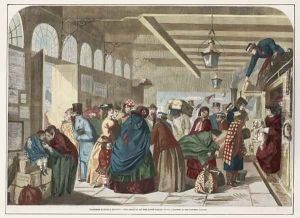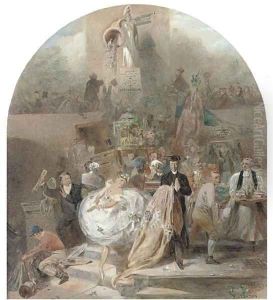Florence Claxton Paintings
Florence Claxton was a British artist and satirist born in 1838. She was active during the Victorian era, a time characterized by rapid change and innovation, as well as by strict social norms and gender roles. Claxton's work often commented on these societal constraints, particularly the role and perception of women in her time.
Claxton was born into an artistic family; her father, Marshall Claxton, was a painter, and her brother was an artist as well. This environment undoubtedly influenced her career path. She studied art at the Female School of Art in Bloomsbury, which was later incorporated into what is now the Central Saint Martins College of Art and Design.
One of her most famous works is 'The Choice of Paris: An Idyll,' created in 1860. This satirical watercolor parodied the Parisian art scene and critiqued the superficiality of artistic judgment and the commodification of female beauty. Another significant work by Claxton is the satirical drawing 'The Woman's Suffrage Movement,' which humorously depicted the consequences feared by many if women were to gain the right to vote.
Throughout her career, Florence Claxton tackled themes such as the role of women in the arts, the commercialization of the art world, and the societal expectations placed upon women. She used her art to challenge the status quo and to comment on the pressing social issues of her day.
Despite her contributions to art and social commentary, Claxton did not achieve the same level of recognition as some of her male counterparts during her lifetime. However, her works have since gained attention and have been featured in various exhibitions, shedding light on the role of female artists in the Victorian era.
Florence Claxton passed away in 1920, leaving behind a legacy as a pioneering female artist who used her work to critique and satirize the society she lived in. Although she may not have been widely known in her time, her art continues to be appreciated for its wit, insight, and historical value.

